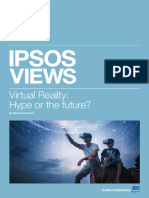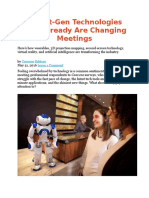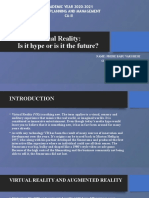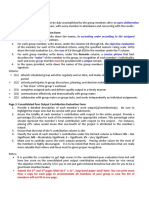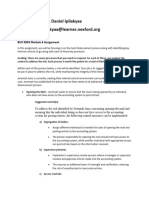Immersive Experiences Using Tech: The Future of Events
Sanjana wanted the best décor for her wedding.
The flowers, the table settings, the cutlery, all had to be handpicked to perfection. Only if she could
visualize what she had in mind. She knew her décor ideas were more than perfect. But how would
she translate her thoughts to the wedding planner and make sure they understand her
requirements? She had little to no idea on what was going to unfold before her eyes till the time she
stepped into the wedding planner’s office.
The wedding planners wows her with an immersive technology powered applications that gives
Sanjana the exact look and feel of the D-day.The app empowers herto visualize and design what she
had in mind for the perfect wedding. She can pick the rightcolor, shade, material and let her
imagination run wild. Sanjana was impressed not just by the approach, but by the efforts the planner
had taken to give life to her imagination.
Events are about crafting experiences
Be it a wedding or a rock concert, event management companies have to do more than just
providing a plan to the organizers. The look, the feel and the appeal, everything has to be narrated.
Augmented reality has made it simpler these days with event management companies constantly
mooting how AR/VR has changed the customer experience. No wonder, the technologies have a far-
reaching consumer base than one could ever imagine.
There’s more to it. Immersive experiences garner much attention and excitement among the
participants, leading to a social media buzz- the most popular means of ‘word-of-mouth’
recommendations. Therefore, even management companies are making their events more
immersive so that they leave a lasting impression on the participant’s mind, encouraging them to
come back for more.
�The future of events is just about scalable with some of the most advanced technologies in the
market such as Virtual Reality, Artificial Intelligence, Big Data and more. But to understand their far-
reaching effects on business, one has to first gauge their scope and functionalities.
Immersive Experiences: Then and Now
Immersive experiences have had different explanations at different points in time, but all of them
rooted in visual and experiential factors. No wonder, there has been a drastic shift from using just
color-prints and photographs to ‘visualize’ an event to using 3D reality to experience the same. The
latter not only helped in better decision-making, but also eliminated any scope of
miscommunication, resulting in loss of time and money.
The one benefit of immersive technology that cannot be ignored is the sheer ability to bring
together dream and reality, thus impacting businesses, economies, and developmental works of the
future.
Types of Immersive Technologies
Immersive technologies can be widely categorized as:
Virtual reality: It immerses the audience in fully artificial digital environment. In other words, the
participant is completely shut out from the world outside while being surrounded by content. This is
possible through a Head Mounted Display (HMD), which transforms the content into a “reality”.
Some of the most common types of VRs include the 360 or 360VR, Mobile VR, True VR, 360 VR vs In-
VR.
One fine example would be an event organized by Bell Helicopter announcing its new copter for the
future. The organizers chose to engage the audiences as participants, letting them to take flight in a
concept aircraft with immersive handsets at HAI Heli-Expo. Instead of just leaving the venue with a
vague concept in their minds, the audience knew what decision they had to take.
�Augmented Reality:This technology overlays virtual objects on the real-world environment. The
most relatable and popular example would be that of Pokemon Go. Digital images of Pokemon were
presented on top of the real world as if they were part of it. In other words, users who use the AR
are not completely shut out from the real world, instead the AR forms extend to their reality. The
retail industry is leveraging into the technology in a great way.
For instance, Target and IKEA have their own apps from where the users can choose a product, for
instance a piece of furniture. Users can place it virtually in their preferred setting and check out if it
fits their requirement pertaining to the color, shape and size. To sum up, this immersive technology
is allowing customers to try out things before even buying them.
Events and planner can stay ahead of the competition by allowing layers on top of what already
exists. This, in fact, could be cost saving because building an AR app could be much lesser than losing
money on event signage. The customers would be happy too.
�Mixed reality: It overlays and anchors virtual objects to the real world. Considered to be the future
of Immersive marketing, it is a combination of VR and AR. Like VR, MR also used HMD, but is not
shut out off the world. Here, the HMD is more like a pair of glasses that superimposes digital images
on top of your environment.
Immersive technology has transformed shared experiences into reality, which is leveraged by the
hospitality sector, the education sector, aviation, event management sector and more. Customers
can now tour wedding venues that were never built, doctors can tour hospitals under planning,
teachers can step into classrooms that are just in the conceptual stage. Do not like the amenities?
Just replace the ‘reality’ with a different one. No time or money lost.
�Future of events with immersive experience
As per an article by the West Agile Labs, a global digital product agency, the future of events is set to
witness a revolutionizing reform with Augmented, Virtual, and Mixed reality trends. The company
believes that combined sector is expected to hit $30 Billion by 2030. Moreover, the consumer
spending on AR & VR technologies is expected to reach $7 Billion by 2020, which is more than any
other industry based on its standalone capacity.
From registering attendees with face recognition technology to navigating the plan for nearest fire
exit in a crowded exhibition, everything is top-notch and fool proof, thanks to the new-age
immersive experience.
The benefits are more than what we can imagine; Some already explored, others yet to be
experienced.
�Growing interaction among attendees: What if somebody really read out your thoughts? Weird to
the extent of fantastic, isn’t it? This will soon happen in symposiums and conferences, when the
attendees could be marked by their thought processes and their areas of interest. A speaker would
know how to tackle the audience he is dealing with. His approach to a particular topic of discussion
could be different.
Turn a gaming event into a real-life experience: A boring trade show or a gaming event is a thing of
the past. Event gamification is the new focus. You can make your conference more interactive with
leaderboards, facilitated games, and networking opportunities. Organizers can now let their
attendees participate in a gaming competition from their seats for a real gaming experience.
�Virtual tours made top notch: Setting up virtual tour guides involves no cost, even though that
means transporting the participant to the destination of their choice. Cultural or tourism events can
leverage greatly on that. Not that they haven’t explored the bandwidth of AR yet, but more
sophistication and innovation is expected in the near future.
Product demo, leading to great decision-making at no cost: Trade shows will shrink, literally.
Imagine a stall for heavy machinery- would you really think of displaying and demonstrating them
�when rents for stations are sky-rocketing. Add to it, the logistical issues. It would just add up to the
cost of the equipment. Instead, use AR and let the customers see how it actually works without
dirtying your hands.
The trends are fast revolutionizing and so are customers’ expectations. It would really be interesting
to witness how the digital space merges with human imagination to build a ‘reality’ that can be
changed, twisted and custom-made according to one’s choice, within seconds.
